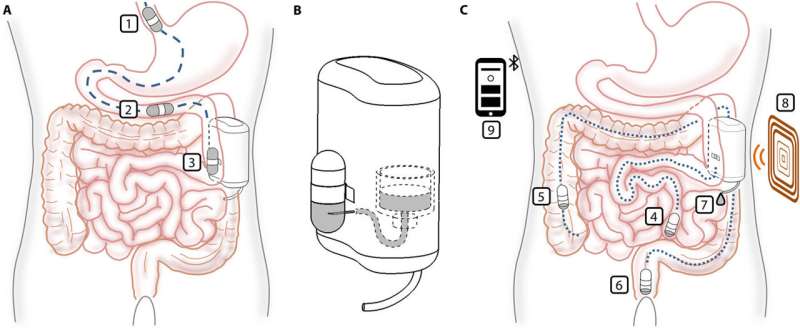August 19, 2021 report
An implantable device for delivering insulin that can be refilled by an ingestible capsule

A team of researchers affiliated with multiple institutions in Italy has developed an implantable insulin delivery device that can be refilled via ingestible capsules. In their paper published in the journal Science Robotics, the researchers describe their device and how well it worked when tested with pigs.
People with Type I diabetes are not able to produce insulin; thus, to remain alive, they must introduce it into their bodies exogenously. There are currently three main options: shots, external pumps and internal pumps. None of these options are optimal, however; shots hurt and can lead to skin toughening, which makes giving the shots difficult. External pumps have to send the insulin through a port in the skin, which can be prone to pain and infection. And internal pumps have to be refilled using a tube accessed through a port in the skin. In this new study, the researchers have created an implantable type of insulin pump that can be refilled by swallowing small capsules.
To allow the pump to remain stable in the body and to allow internal refilling, the researchers placed it in a gut cavity adjacent to a part of the large intestine. They then added magnets and motors to capture a capsule as it moves through the intestine. Once captured, the capsule is turned automatically by the magnets to align it properly with the pump. Next, a needle extrudes from the pump, through the intestine and into the capsule. The pump then draws the insulin from the capsule into a storage bank. Once the capsule is depleted, the needle retracts and the capsule continues its journey through the intestine until excreted. The pump slowly releases insulin into the gut cavity, allowing it to be absorbed into the bloodstream, where it is used by the body to manage glucose levels. The device's battery is charged wirelessly through the skin.
The researchers found that the device worked as expected in test pigs, but note that more work is required to stabilize the system before it can be tested in humans.
More information: Veronica Iacovacci et al, A fully implantable device for intraperitoneal drug delivery refilled by ingestible capsules, Science Robotics (2021). DOI: 10.1126/scirobotics.abh3328
© 2021 Science X Network




















